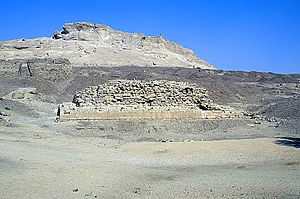 Step pyramid, 4th dynasty, in the background the el-Kōm el-aḥmar | ||
| Zāwiyat el-Maiyitīn · زاوية الميتين Zāwiyat Sulṭān · زاوية سلطان | ||
| Governorate | Minyā | |
|---|---|---|
| Residents | 12.891 (2006) | |
| no tourist info on Wikidata: | ||
| location | ||
| ||
Zawiyat el-Maiyitin (Arabic:زاوية الميتين, Zāwiyat al-Maiyitīn / Maitīn, زاوية الأموات, Zāwiyat al-Amwāt, „Angle of the deceased“, زاوية سلطان, Zāwiyat Sulṭān, „Sultan's angle“) Is a village in Middle Egypt on the eastern bank of the Nile between the villages Sawada and Benī Ḥasan, about 10 km south of el-Minyā. In the south of the village is the archaeological site at el-Kōm el-aḥmar (Arabic:الكوم الأحمر, al-Hardly al-Aḥmar, „the red hill“), The ancient one Hebenu.
background
The burial site was primarily used for burials in the Old and New Kingdoms. In the Old Kingdom a step pyramid was erected in front of it, the Temple of Amenhotep III comes from the New Kingdom. for Horus. In Roman times a settlement was built here and the area was used as a quarry.
The ancient Egyptian name Hebenu goes back to the verb for "kill with a knife". It is said that this has a relation to the god Horus, who is worshiped here, who avenged himself on the god Seth for the death of Horus ’father Osiris.
getting there
The village and the archaeological site are located directly on the new asphalt road from el-Minyā to Benī Ḥasan. Depending on whether you want to reach other destinations or are traveling with several people, the price for a taxi is around LE 200–300 for one day.
mobility
The village and the archaeological site can be explored on foot without difficulty.
Tourist Attractions
The archaeological site el-Kōm el-Aḥmar is located in the south of the village. Admission costs LE 40 and for foreign students LE 20 (as of 11/2019).
Buildings







- The 1 Step pyramid(28 ° 2 ′ 45 ″ N.30 ° 49 '43 "E), a dummy pyramid from the 3rd or 4th dynasty, is located to the west of the hill, almost directly on the road. There are similar pyramids at Seilā, at Naqada, South from Abydos, north of Hierakonpolis, five kilometers south of Edfu and up Elephantine. The local pyramid is the easiest to reach and is the only one on the Nilostufer. The square limestone pyramid has an edge length of around 22 m and is still around 5 m high today. Its original height is said to have been 17 m. Like all other comparable pyramids, it has no corridors or chambers. The function of these pyramids is in the dark: symbols of power of the ruling pharaoh, ancient mounds or cenotaphs (proxy graves) of the king's wives are discussed as possible. The builder is also controversial: mostly the pharaoh is called Huni.
- There is one north of the step pyramid Temple complex for Horus of Hebenu from the time of Amenhotep III, on which construction was continued until the time of Ramses II. There are a few building fragments of the temple, which e.g. also depict Pharaoh Amenophis III. demonstrate.
Graves in the burial hill
- The graves of the Old Kingdom include that of the Chunes (Grave 2) and that of the Nianch-Pepi, both were heads of the residence. These graves are not accessible. Those who are lucky can perhaps visit the tomb of Nianch-Pepi.
- In the rocky hill behind are graves from the New Kingdom, the most important of which is that of the 2 Nefersecheru(28 ° 2 '47 "N.30 ° 49 ′ 54 ″ E), Grave 1. Nefersecheru was a royal clerk and asset manager at the end of the 18th and the beginning of the 19th dynasty. This grave is accessible. The burial chamber is divided by a row with two pillars and pilasters on the walls. The shaft to the burial chamber is located in the area of the pillars. The grave is decorated, even if the decoration is poorly preserved. Offenders and the list of victims are depicted on the left entrance wall. The depictions on the left wall include a hymn to Osiris, the kneeling tomb lord and that of the tomb lord and his wife, as led by Horus to the four sons of Horus and Osiris and Nephthys. The back of the chamber contains three niches with the remains of statues - probably those of the grave lord, his wife and those of his mother. On the right-hand side near the back wall you can see the grave lord and his wife in front of two shrines as well as men and women sacrificing. The western part of the right wall is taken up by funeral rites and processions such as the bringing of the grave equipment. There is an associated chapel in the south of the grave facade.
Muslim cemetery
In the east of the village along the foot of the rock is the name-giving Muslim cemetery over a length of approx. 6 km.
shop
kitchen
accommodation
Accommodation options exist in el-Minyā.
trips
The visit of Zāwiyat al-Maiyitīn can be combined with a visit to the Deir Aba Hōr monastery in Sawada and the archaeological sites of Benī Ḥasan and Isṭabl ʿAntar connect.
literature
- Popular scientific literature:
- : The pyramids. Reinbek: Rowohlt, 1998, ISBN 978-3499608902 , P. 196.
- Scientific literature:
- : To the small step pyramids of Upper and Central Egypt. In:Communications from the German Archaeological Institute, Cairo Department, ISSN0342-1279, Vol.36 (1980), Pp. 43–59, especially pp. 54–59, a map, tables.
- : The grave of Nefersecheru in Zawiyet Sulṭan. Mainz: from Zabern, 1992, Archaeological publications; 88, ISBN 978-3-8053-1012-3 .
- : La tombe de Ni-Ankh-Pepi à Zâouyet el-Mayetîn. Le Caire: Impr. De l'IFAO, 1938, Mémoires / Institut Français d’Archéologie Orientale du Caire; 70.
- : The pyramid of Zawyet Sultan: local perspectives. In:Sokar: History & Archeology of Ancient Egypt, ISSN1438-7956, Vol.19,36 (2018), Pp. 6-19.



